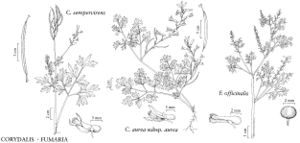Fumaria
Sp. Pl. 2: 699. 175.
Gen. Pl. ed. 5, 314. 1754.
| Taxon | Illustrator ⠉ | |
|---|---|---|
 | Corydalis sempervirens Corydalis aurea subsp. aurea Fumaria officinalis | John Myers John Myers John Myers |
Herbs, annual, caulescent, from taproots. Stems erect to reclining, branching. Leaves cauline, sometimes also basal, compound; blade with 3-4 orders of leaflets and lobes, margins entire, surfaces glabrous. Inflorescences terminal on main-stem and leaf-opposed branches, racemose. Flowers bilaterally symmetric about 1 plane; sepals peltate with attachment near base, ovate, base rounded, margins ± lacerate, apex acute to acuminate; outer petals inconspicuously crested, one basally spurred; stamens with filaments of each bundle completely connate, adhering basally to petals; ovary ovoid; style promptly deciduous after anthesis, elongate; stigma ± 2-lobed. Capsules indehiscent. Seed 1, elaiosome absent.
Distribution
Eurasia, Africa, and Atlantic islands, with greatest diversity in w Mediterranean region
Discussion
Species ca. 50 (3 in the flora).
Fumaria parviflora Lamarck was reported as adventive from Europe in central Texas by D. S. Correll and M. C. Johnston (1970) and in central and southern coastal California by J. C. Hickman (1993). In the former treatment F. parviflora is said to differ from F. officinalis by having leaf segments with channeled lobes, and capsules obtuse to apiculate or beaked, while in the latter treatment it is reported to differ from that species by having shorter (3-4 mm), cream-colored petals, the inner ones tipped purple, and ± crested capsules. Evidently, the species is found in North America only as a waif and is not naturalized here. Fumaria martinii Clavaud, a synonym of F. reuteri Boissier according to M. Lidén (1986), was reported from southwestern British Columbia by B. Boivin (1966), but I have not seen specimens. Fumaria bastardii Boreau also has been reported from British Columbia, as an infrequent garden escape on roadsides, in waste places, and at forest edges in the southern part of the province (G. W. Douglas et al. 1989). It differs from F. officinalis in that the corolla is dark pink and 10-12 mm long.
Selected References
None.
Lower Taxa
Key
| 1 | Pedicels rigidly arcuate-recurved in fruit; capsules smooth or nearly so; corolla 9–14 mm. | Fumaria capreolata |
| 1 | Pedicels straight and spreading to ascending in fruit; capsules slightly wrinkled, warty, pebbled, or shallowly pitted; corolla 5–9.5 mm. | > 2 |
| 2 | Corolla 6–9.5 mm, spur ca. 2.5 mm. | Fumaria officinalis |
| 2 | Corolla 5–6 mm, spur 1–1.5 mm. | Fumaria vaillantii |
"thin" is not a number.